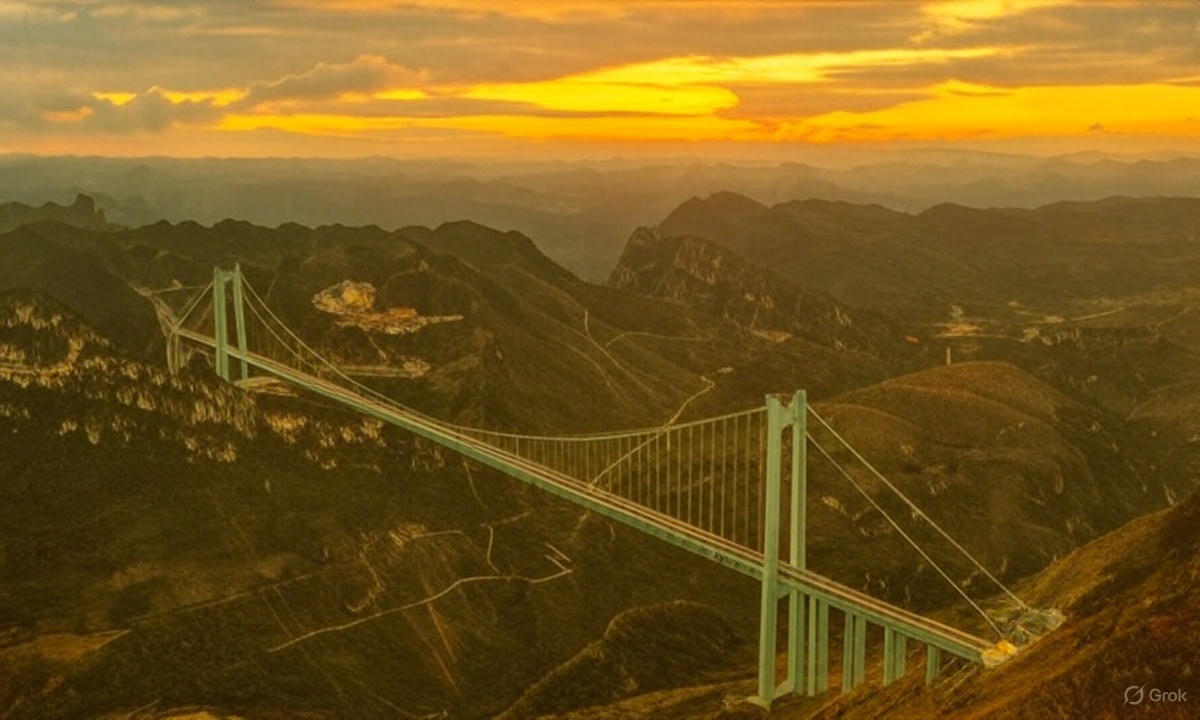China’s Huajiang Grand Canyon Bridge: Engineering Marvel and Tourist Magnet
Introduction
China has officially opened the Huajiang Grand Canyon Bridge, now recognized as the world’s tallest bridge, towering 2,051 feet (625 meters) above the Beipan River. Announced on October 4, 2025, this project has not only broken height records but also transformed into a major tourist destination, combining breathtaking views with adventure activities.
NEW: China officially opens the world’s tallest bridge, completing the project in under 4 years.
— Collin Rugg (@CollinRugg) October 4, 2025
The bridge features a restaurant at the top, a whopping 2600 ft above the river.
The bridge not only cuts a 2-hour drive to 2 minutes, but also features as a theme park with a glass… pic.twitter.com/5lUA2XwjbV
Major Highlights of the Huajiang Grand Canyon Bridge
Unmatched Height and Span
Soaring 2,051 feet above the Beipan River, the bridge overtakes the Duge Bridge (1,854 feet) as the tallest. Its main span measures 4,660 feet, and the total length exceeds 9,777 feet, making it the longest bridge in a mountainous region.
Fast-Track Construction
The bridge was completed in just 3 years and 8 months, demonstrating China’s efficiency in large-scale infrastructure projects.
Significant Travel Time Reduction
Crossings that once took 2 hours via winding roads can now be completed in just 2 minutes, transforming connectivity in the region.
Adventure and Scenic Experiences
- Glass Skywalk: Walk high above the canyon for unmatched views.
- High-Speed Elevator: Ascends to 2,600 feet for a panoramic lookout and café.
- Thrill Activities: Bungee jumping, with skydiving and paragliding planned.
Artificial Waterfall with Nighttime Effects
A 300-meter cascading waterfall is complemented by rainbows and light shows, creating a visual spectacle day and night.
Café with a View
Visitors can enjoy refreshments at an elevated café while taking in dramatic canyon scenery.
Global Attention
The bridge has sparked worldwide discussion, highlighting China’s rapid construction capabilities compared to delayed projects elsewhere.
Why This Bridge Matters
The Huajiang Grand Canyon Bridge is more than a transport structure; it is a symbol of engineering excellence and tourism innovation. By combining utility and entertainment, China has set a benchmark in global infrastructure, showing how bridges can serve as both connectors and attractions.
FAQs
Q1: Where is the Huajiang Grand Canyon Bridge located?
A1: In Guizhou province, southern China, spanning the Beipan River.
Q2: How tall is the bridge?
A2: The bridge stands 2,051 feet (625 meters) above the river.
Q3: Can visitors engage in adventure sports on the bridge?
A3: Yes, it features bungee jumping, a glass skywalk, and plans for skydiving and paragliding.
Q4: How long did construction take?
A4: Approximately 3 years and 8 months, completed in 2025.
Q5: What makes the bridge a tourist attraction?
A5: It offers a glass walkway, high-speed elevator, artificial waterfall, café, and panoramic views, making it a thrilling experience.
Conclusion
The Huajiang Grand Canyon Bridge exemplifies the fusion of rapid infrastructure development and tourism innovation. It stands as a testament to China’s ability to execute ambitious engineering projects that are both functional and experiential. As more visitors arrive, it is poised to become an iconic landmark, inspiring awe and sparking global discussions on the potential of infrastructure as a driver of economic growth and adventure tourism.
In neutral intellectual terms, this bridge represents the next frontier in civil engineering: integrating record-breaking height, advanced construction techniques, and immersive human experiences, all while setting new standards for tourism-driven infrastructure. Its success may reshape how countries approach future large-scale bridge projects.


0 comments